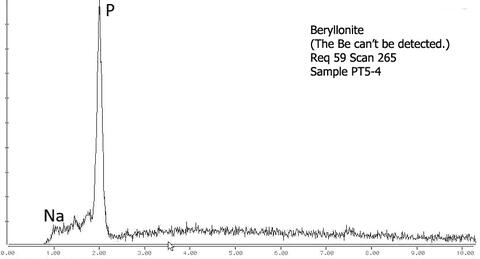Beryllonite is a rare mineral at MSH. Compared to other localities, the crystals are very small. The ones on this specimen are about 0.35 mm in maximum diameter. But, for the locality, this very small specimen offers very good coverage. Moreover, the specimen is from an analyzed find (see the “Analysis” tab). In addition, the specimen features small crystals of rémondite-(Ce) (also analyzed) and gaidonnayite on smoky quartz and siderite. There is even a very small (insignificant) crystal of red-brown neighborite.
Rémondite-(Ce) is a very rare mineral, known only from a half-dozen localities. It is rare at MSH. MSH is the TL for gaidonnayite. It is uncommon but not rare here. (See after the photo descriptions for comments regarding the IDs.)
The beryllonite and some of the rémondite-(Ce) are shown in the first pair of photos (FOV 1.9 x 2.9 mm). The rémondite needles are <= 0.45 mm long.
The second pair of photos (FOV 1.8 x 1.1 mm) shows one of the gaidonnayite crystals (brightly lit) and more of the rémondite. The gaidonnayite crystal is ca 0.25 mm wide; the rémondite < 0.55 mm long. This is not a significant specimen for either mineral. But the gaidonnayite is glass-clear and very sharply formed.
The third pair of photos (FOV 2.0 x 2.9 mm) shows the largest rémondite crystals on the specimen (top - 0.8 mm) along with a couple of beryllonite crystals (near the center - ca 0. 2 mm) and another gaidonnayite crystal (bottom – 0.25 mm on edge).
Small as it is, this specimen exhibits the marvelous complexity typical of MSH. More importantly, it has a (relative) abundance of one of the rarities at MSH – namely beryllonite.
Regarding the IDs:
Be cannot be detected via EDS, so the beryllonite ID is based on the presence of (only) P and Na in the scan in conjunction with the habit and occurrence. (Note that Na is only weakly detected by this equipment. That puny peak actually implies the presence of substantial Na relative to P.)
Chemically, rémondite-(Ce) and petersenite-(Ce) are very similar. Qualiative EDS by itself is probably not sufficient to distinguish these minerals. However, most habits of rémondite-(Ce) at MSH, including this one, are visually distinct from petersenite-(Ce).
Scans for parisite-(Ce) can also look similar but the Ca peak is generally higher relative to Ce because Ca is essential in parisite, but not in rémondite. Also, parisite has no Na. While the Na peak in this scan may look puny, it is actually quite significant because Na is difficult to detect with this equipment.
That said, please note that these are just qualitative EDS scans and peak heights in such scans can be very misleading. I have added a scan comparing the rémondite-(Ce) on this specimen with parisite-(Ce) from another specimen. The differences are subtle, and could be due to factors other than actual differences in composition. However, a sample of red-orange rémondite-(Ce) produced a scan essentially identical to the one for this specimen.
Single item shipping weight is 2.7 oz (77 g). For shipments outside the USA, up to a total weight < 8 oz (225g), this can be combined with items from this or other auctions for the same postage.
Within the USA, postage increases by about $0.20 per ounce. Above 13 oz, I will use Priority Mail ($9.25 including packing).


























